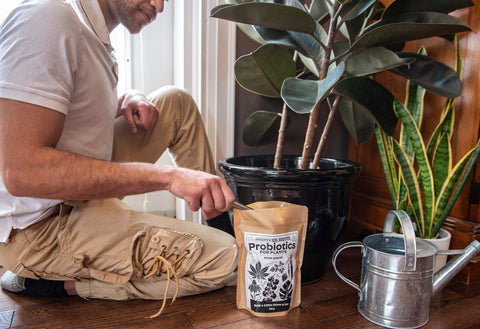Get Microbes Working for You:
How Worm Castings Help Plants Combat Pests
We know what a worm looks like on the outside, but how much do you know about the inside of a worm? Unlike us, a worm has a two part stomach, the crop and the gizzard, plus an intestinal tract. When food passes through the crop and gizzard, it is physically broken down as enzymes (sticky glue-like liquids) are secreted. The glue-covered food ball then enters the intestine’s microbiome. The microbiome is like a city with all kinds of different microbes living and working in the community. When the gluey food ball rolls through that city, a bunch of microbes get stuck to it. Eventually this is pooped out by the worm and is called a worm casting (or Worm Manure).
Chitinase: A Natural Enzyme that Degrades Insects Comes from Worm Castings
Each worm casting contains a similar, but unique, microbial ecosystem including enzyme secretions. The chitinase enzyme produced by the worm’s microbiome is especially important for protecting plants against insect pests. This is because chitinase degrades chitin, the main component in many insects’ exo-skeleton. When an insect eats a plant leaf holding chitinase, the insect’s stomach will dissolve and that bug will die. How does the chitinase from the worm casting get into the leaves of plants?
Plants Incorporate Chitinase as a Defense Mechanism
This is where microbes come into play. When microbes from the worm’s gut are absorbed into the soil, they bring the chitinase with them. This chitinase, along with other nutrients, are delivered to the roots where the plant absorbs these into its vascular system. A plant’s vascular system is like a human’s cardiovascular system. Vascular tissue runs through the entire plant and transports chitinase up to the leaves. Some of the chitinase is stored in the leaf while the rest is secreted through the outer cells of the plant, like a plant sweat. Plants grown with worm castings will have a coating of chitinase on the outside of their leaves and stored internally.
Microbes on the Outside of Plants Offer Physical Barriers Against Pests
Other beneficial organisms are also delivered this way and provide further immunity boosts to the plants. Beneficial microorganisms create a microbiome on the leaves of plants. Let’s go back to imagining the microbiome as a city. City-like microbiomes have borders and limited space. Plant leaves are only so big and have limited ability to hold microorganisms inhabiting that area. A leaf microbiome thick with beneficial microbes will act as a physical barrier against pests or pathogens that land on the leaf, preventing them from accessing the leaf tissue required to inflect damage or disease.
Traditional Pesticides Hurts All Microorganism, Including the Good Ones
So why use worm castings as a pest control technique when a chemical pesticide has immediate, guaranteed results? Traditional chemical pesticides can't differentiate between good and bad microorganisms; they simply kill everything. Therefore when a plant is treated with a chemical pesticide, all the microbes in the local microbiome will be damaged. Consequently, nutrients and enzymes, such as chitinase, are not delivered to the plant’s root system, leaving the plant without natural microbial defenses and susceptible to further pest infestations.
Supporting healthy soil microbial diversity and maintaining a pest-free garden is possible and simple. Add worm castings (Worm Manure) to your soil when starting seedlings, transplanting, observing signs of plant stress, or noticing pest activity. Avoiding traditional chemical pesticides and using worm castings instead will help ensure you grow healthy plants, healthy people, and a healthy planet.


